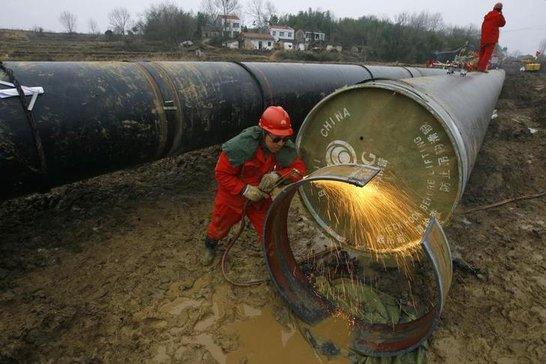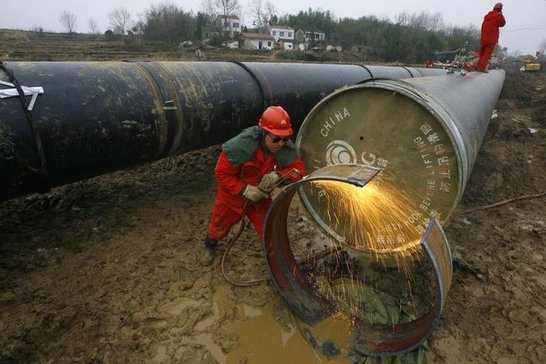
China's energy heavyweights Sinopec Corp and PetroChina have upgraded their outlook on the country's shale gas industry, citing steadily declining costs, but stopped short of predicting a near-term boom.
China, estimated to hold the world's largest technically recoverable shale resources, is hoping to replicate the shale boom that has transformed the energy landscape of the United States. Industry experts caution that it would be much more difficult for China to monetise its shale gas reserves than the U.S. as it faces serious challenges from water shortages to complicated geological structure and a lack of infrastructure.
But top executives at China's two biggest energy companies conveyed a bullish assessment of the country's shale gas potential last month, citing rapidly falling drilling costs and rising domestic gas prices. That's a far cry from two years ago when they overwhelmingly focused on the hurdles faced by China.
"It took the U.S. nearly four decades to achieve large-scale production. We are at the early stage, but we don't need to spend three decades. Cost will come down sharply," Sinopec Chairman Fu Chengyu told reporters at the firm's interim results briefing in Hong Kong.
"We have found that there is big room for cost reduction ... Also, domestic gas prices are being raised, so these two factors will lead to greater investment," he said.
The cost of shale gas drilling at Sinopec's Fuling field in southwestern China - the country's largest shale gas project - has been falling steadily to about 60 million yuan ($9.8 million) per well, Fu said.
That is still double the average shale gas drilling cost in the U.S. but represents a significant fall from 100 million yuan in China just several years ago, analysts say.
Fu said he expected costs to decline to 50 million yuan per well within three to five years. "It is dropping fast. Because of better expertise and experience, there is a lot of room for further cost decreases," he said.
But some shale gas experts say the Fuling success is hard to repeat due to its unique geological structure.
Back to topNew optimism
Fu's optimism was echoed by PetroChina's Vice-Chairman and President Wang Dongjin, who told reporters that China's dominant oil and gas producer had decided to kick off shale gas development this year with a 7 billion yuan budget.
PetroChina is keeping its drilling cost at 55 million yuan per well and will strive to keep it under 50 million yuan, he said. He said the average time PetroChina spends on shale gas drilling - a process known as hydraulic fracturing - had fallen to 45 days per well from more than 80 days.
But Fu and Wang ruled out the possibility of a shale gas boom in the near future, saying costs must come down much more and gas prices must rise further to justify a substantial step-up in investment.
Indeed, China early last month halved its 2020 shale gas production target after early exploration efforts to unlock the unconventional fuel proved challenging, according to an industry website and a government source.
Citing Wu Xinxiong, the head of China's National Energy Administration, industry website www.cpnn.com.cn reported that China aims to pump 30 billion cubic metres (bcm) of shale gas by 2020, versus an earlier goal of 60bcm to 80 bcm mapped out in 2012.
At Fuling, where Sinopec is building the first phase of the project, the company aims to put in an annual production capacity of 5 bcm by end-2015, Fu said. By end-2017, Sinopec will double it to 10 bcm.
PetroChina's Wang said his company will have an annual shale capacity of 2.6 bcm by end-2015 and overtake Sinopec in terms of shale gas output in the next few years.
"We are confident we will have a breakthrough in shale gas development in China," he said.
---------------------------------------------------------------------------------------------------------------------------------
Back to topCould shale revive China's flagging oil fields?
By John Kemp of Reuters
"I believe and will prove that our country is not deficient in oil reserves. If I can use my 20-year lifetime in exchange for a large oil field, I will."
Those comments, recorded in an illustrated history of the Songliao Basin published by China National Petroleum Corp (CNPC), are attributed to Wang Jinxi, an oil field worker who became a hero of Communist China during the 1960s and 1970s.
Wang's Drill Team No. 1205 was credited with doing more than any other team to develop the super-giant Daqing oil field amid the frozen swamps of northeast China.
"Despite the harsh and extremely cold environment, he and his [team] members transported and installed rigs by pulling and piggybacking, and supplied water in basins and buckets for spud-in. In fact, they finished the first oil well of the 'battle' in only five days and four hours, a record at the time," according to CNPC.
"To suppress a blowout from the second well they were drilling, Wang, with an injured leg, mixed mud with his body in a waist-deep mud pond. His energy to work day and night and capacity to fulfill even the most challenging task gained him the reputation of Iron Man."
Wang, originally a poor peasant from Gansu province, ended up being elected to the Communist Party's Central Committee in 1969.
It is hard to separate the myth-making from the reality, but there is no doubting the immense achievement that the Daqing oil fields represented. They were the first fields developed entirely with Chinese expertise, rather than with help from the Soviet Union.
The battle for Daqing, which is how it was described at the time, liberated China from its "longstanding slavish dependence" on foreign oil, according to Premier Zhou Enlai (Oil in China: From self-reliance to internationalisation, 2010).
Daqing is central to the history of modern China. No place played a more important role in the second half of the 20th century, except Shenzhen, the special economic zone next to Hong Kong, associated with reform and opening and the economic policies of Deng Xiaoping.
Self-reliance
The first successful Daqing well was drilled in 1959, when China barely had any domestic oil production and relied almost entirely on imports. By 1973, production from Daqing had grown so much that China became a net oil exporter, a status it would retain for the next 20 years.
Daqing became a symbol of energy independence. "Because of the discovery and construction of the Daqing oil field, our country's economic construction, the oil needs of defence and civilian applications, which had depended on foreign imports in the past, are now basically self-reliant," Premier Zhou proudly told the National People's Congress in 1963.
Daqing also became a metaphor for modernisation. Zhou, Deng, and even Jiang Qing, the wife of Chairman Mao Zedong, all visited Daqing and employed it as a model for the development of the economy.
In 1963, Mao himself pronounced that the rest of China's industry should "learn from Daqing" and thereby launched an industrial and political philosophy that became known as "Daqing-ism," a blend of technocracy, heroism and ideology.
But Daqing was more than just a symbol. The field was the single most important contributor to the state budget from the 1960s through the early 1980s and a vital source of foreign exchange earnings as China began the long, slow modernisation of its economy.
Daqing's petroleum engineers and managers became known as the "petroleum faction" - an elite and one of the most influential and respected groups in the party and the state.
Ageing supergiant
Everything about Daqing is on a superlative scale. It is one of the largest oil fields in the world. In 1976, production hit 1 million barrels per day, and it was sustained at that level for another 27 years before being slowed by 20 percent in 2004.
By 1985, China was the world's sixth-largest petroleum producer after the Soviet Union, the United States, Saudi Arabia, Mexico and the United Kingdom. Daqing alone accounted for about half of its total output.
In 2009, China National Petroleum Corp announced cumulative production had reached 2 billion tonnes (around 14.6 billion barrels). That ranks Daqing in a tiny elite group of "supergiant" fields along with Saudi Arabia's Ghawar, Mexico's Cantarell, Russia's Samotlor and the East Texas Field in the United States.
But Daqing is getting old. Field pressure, the reservoir's natural energy, has dropped, making the oil harder to produce. So CNPC has resorted to a variety of methods to maintain production rates and try to scrape more oil from the reservoir.
"Nearly every sort of enhanced recovery method has been tried at Daqing," according to Stephen Rassenfoss at the Journal of Petroleum Exploration and Production Technology. The reservoir has been injected with water, carbon dioxide, surfactants and polymers to drive more of the remaining oil towards the wells.
The discovery of oil at Daqing brought China self-sufficiency for more than a quarter of a century and made it a net exporter from 1973 to 1993. But China's production has levelled off at best, while its oil demand has boomed.
China has overtaken the United States and Japan to become the biggest oil importer in the world. Once more, the country is threatened by its dependence on foreign oil.
Back to topShale formations
Out of necessity, CNPC has become a world leader in enhanced oil recovery at Daqing.
But the shale revolution has opened up yet another intriguing possibility. Perhaps China could produce oil direct from the thick shales that are the source of much of the petroleum found in Daqing's conventional oil and gas fields and thereby, extend the life of the field for many more decades.
Shale oil and gas tends to be found in much of the same locations as conventional oil and gas fields. In fact, shale formations are normally the source of the petroleum trapped in conventional fields.
Bakken in North Dakota and the Eagle Ford and Permian shales in Texas were the source of the oil and gas extracted from conventional fields in both states for decades before the shale boom.
But horizontal drilling and hydraulic fracturing have enabled producers to target the source directly rather than having to hunt for accumulations of oil and gas, which have been expelled from the source rocks and then become trapped in a more permeable reservoir rock.
China has at least six large onshore sedimentary basins that are highly prospective for oil and gas, including the Songliao Basin that is home to Daqing. Most of the attention has been focused on gas, but these basins also contain large quantities of oil.
The U.S. Geological Survey describes the area around Daqing as "a nearly featureless landscape having less than 50 metres of relief and numerous lakes, swamps and rivers." It is very hot in summer and bitterly cold in winter.
The Daqing oil fields cover an area of just 10,000 square kilometres or so located in the centre of the basin, stretching 138 kilometres north-south and 73 kilometres east-west.
But the source of much of the oil in the Daqing is the enormous Qingshankou shale formation, which extends across a much bigger area of 87,000 square kilometres. The most promising part of the Qingshankou shale is 200 to 400 metres thick and buried up to 2,500 metres below the surface.
The U.S. Energy Information Administration (EIA) estimates that Qingshankou could contain around 229 billion barrels of oil, of which 11.5 billion might be technically recoverable, as well as 155 trillion cubic feet of gas, of which 16 trillion cubic feet might be technically recoverable.
Back to topThe prize
If the EIA's estimates are even roughly correct, fracking could double the amount of oil recoverable from Songliao. Qingshankou could produce as much in future as Daqing has produced over the last 50 years.
The potential has not gone unnoticed. In 2010, Hess Corp and CNPC conducted a joint study of the shale/tight oil potential at the Daqing oil field. Hess and CNPC are still working on unconventional exploration, but now in the Santanghu Basin in northwest China.
There is a lot of uncertainty about whether the Qingshankou can be fractured successfully. The major oil and gas producing shale in North America that are currently in production, such as the Bakken and Eagle Ford, were all deposited on the floor of ancient seas. But Qingshankou was deposited on the floor of an ancient lake.
"The Songliao Basin lacks a suitable commercial North American shale analog as it is structurally complex and of lacustrine sedimentary origin," according the EIA.
The silt deposited in ancient lakes is much more fine-grained than marine sediments, more like clay, and harder to fracture. It is not clear whether oil could be produced using the same techniques. But the potential prize is enormous.
In October 2013, CNPC and Shell agreed to set up a joint Shale Oil Research Centre to be based in the United States and China. The research programme will focus on theoretical aspects of shale geology for three years before shifting to engineering research and development.
In the announcement, CNPC focused on the potential for research on shale oil, rather than gas, including continental (i.e lacustrine) shales in China, suggesting that CNPC is alive to the potential for onshore shale oil production.
The need to find and develop more oil reserves is again urgent for China, and hunting for more oil around the Daqing oil fields is one of its most promising options.
Back to top





